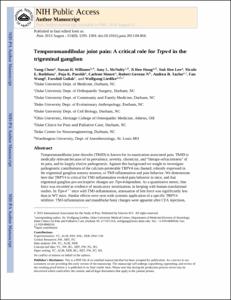KUMEL Repository
1. Journal Papers (연구논문)
1. School of Medicine (의과대학)
Dept. of Anesthesiology & Pain Medicine (마취통증의학)
Temporomandibular joint pain: A critical role for Trpv4 in the trigeminal ganglion
- Keimyung Author(s)
- Hong, Ji Hee
- Journal Title
- Pain
- Issued Date
- 2013
- Volume
- 154
- Issue
- 8
- Abstract
- Temporomandibular joint disorder (TMJD) is known for its mastication-associated pain. TMJD is medically relevant because of its prevalence, severity, chronicity, the therapy-refractoriness of its pain, and its largely elusive pathogenesis. Against this background, we sought to investigate the pathogenetic contributions of the calcium-permeable TRPV4 ion channel, robustly expressed in the trigeminal ganglion sensory neurons, to TMJ inflammation and pain behavior. We demonstrate here that TRPV4 is critical for TMJ-inflammation-evoked pain behavior in mice and that trigeminal ganglion pronociceptive changes are TRPV4-dependent. As a quantitative metric, bite force was recorded as evidence of masticatory sensitization, in keeping with human translational studies. In Trpv4(-/-) mice with TMJ inflammation, attenuation of bite force was significantly less than in wildtype (WT) mice. Similar effects were seen with systemic application of a specific TRPV4 inhibitor. TMJ inflammation and mandibular bony changes were apparent after injections of complete Freund adjuvant but were remarkably independent of the Trpv4 genotype. It was intriguing that, as a result of TMJ inflammation, WT mice exhibited significant upregulation of TRPV4 and phosphorylated extracellular-signal-regulated kinase (ERK) in TMJ-innervating trigeminal sensory neurons, which were absent in Trpv4(-/-) mice. Mice with genetically-impaired MEK/ERK phosphorylation in neurons showed resistance to reduction of bite force similar to that of Trpv4(-/-) mice. Thus, TRPV4 is necessary for masticatory sensitization in TMJ inflammation and probably functions upstream of MEK/ERK phosphorylation in trigeminal ganglion sensory neurons in vivo. TRPV4 therefore represents a novel pronociceptive target in TMJ inflammation and should be considered a target of interest in human TMJD.
- Keimyung Author(s)(Kor)
- 홍지희
- Publisher
- School of Medicine
- Citation
- Yong Chen et al. (2013). Temporomandibular joint pain: A critical role for Trpv4 in the trigeminal ganglion. Pain, 154(8), 1295–1304. doi: 10.1016%2Fj.pain.2013.04.004
- Type
- Article
- ISSN
- 0304-3959
- Appears in Collections:
- 1. School of Medicine (의과대학) > Dept. of Anesthesiology & Pain Medicine (마취통증의학)
- 파일 목록
-
-
Download
 oak-aaa-04097.pdf
기타 데이터 / 2.34 MB / Adobe PDF
oak-aaa-04097.pdf
기타 데이터 / 2.34 MB / Adobe PDF
-
Items in Repository are protected by copyright, with all rights reserved, unless otherwise indicated.